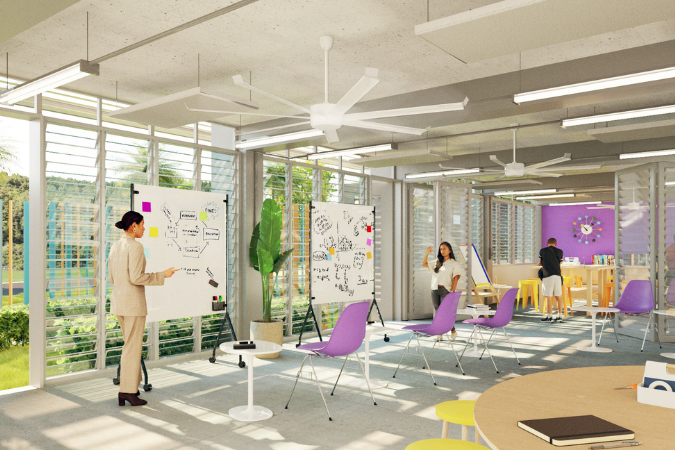8 Solutions for Sustainable School Design
Written By AD&V®ABOUT THE AUTHOR | AD&V® is dedicated to advanced and energy-efficient sustainable architecture & interior design that enhances people’s experience of the world and improves their lives.
CREATING A SUSTAINABLE SCHOOL ENVIRONMENT IS NOT JUST ABOUT REDUCING CARBON FOOTPRINTS; IT'S ABOUT FOSTERING A CULTURE OF RESPONSIBILITY AND ENVIRONMENTAL STEWARDSHIP AMONG THE NEXT GENERATION.
Schools can become exemplars of sustainability through innovative design and thoughtful practices.
Let's explore some practical solutions for sustainable school design that can benefit both the environment and the overall learning experience.
1. UTILIZE MODULAR CONSTRUCTION
Modular construction, also known as offsite construction, provides a versatile, cost-effective, and eco-friendly alternative to traditional building methods. These structures are manufactured piece by piece in a controlled factory environment, significantly reducing pollution and gas emissions.
It also allows for the use of sustainable materials and ensures minimal environmental disruption during the construction process.
2. SOURCE SUSTAINABLE MATERIALS
Incorporating sustainable or recycled materials into school buildings reduces environmental impact and promotes energy efficiency. Reusing materials from older or derelict buildings and sourcing from sustainable sources are effective ways to ensure environmental friendliness.
Salvaged materials, such as timber, brass, and porcelain, can be repurposed, offering superior insulation and durability compared to traditional materials.
3. INCORPORATE PLANTS
Integrating plants into the school's design and within school grounds can significantly improve air quality and provide a calming environment for students.
Vertical gardens and green spaces can also serve as educational tools, teaching students about the importance of nature in sustainable living. This makes the learning environment more conducive to study.
4. CREATE ADAPTABLE SPACES
Designing adaptable spaces that can serve multiple purposes helps in reducing the spatial footprint of schools. Smart furniture that transforms to meet different needs can make classrooms more versatile, allowing them to be used for various activities without requiring extensive resources.
This approach maximizes the utility of available space and enhances the overall efficiency of the school's infrastructure.
Explore the Baldwin Innovation Center through an immersive tour, with the option to enhance your experience using Virtual Reality goggles:
5. COMPREHENSIVE RECYCLING PROGRAMS
Implementing robust recycling programs within schools can significantly reduce waste. Providing separate bins for different types of recyclables and educating students on proper recycling practices are essential steps.
These initiatives not only decrease the school's environmental footprint but also instill recycling habits in students.
6. EXPLORE ENERGY-EFFICIENT DESIGN
Implementing energy-efficient designs is vital for sustainable school buildings. This includes installing low-flow amenities, on-demand heaters, programmable thermostats, and solar panels.
Additionally, proper insulation and ventilation systems ensure that a building maintains a stable internal temperature, reducing the need for heating and cooling. These strategies reduce energy consumption and operational costs while promoting a sustainable future.
7. CLASSROOM COMPOSTING
Setting up composting systems for classroom and cafeteria food waste can significantly reduce landfill contributions and provide a hands-on learning experience about sustainability and waste management.
This nutrient-rich compost can also be used for school gardens and can help students gain practical skills and an appreciation for the cycle of organic matter.
8. OUTDOOR CLASSROOMS
Creating outdoor classrooms and learning spaces encourages interaction with nature and can enhance students' environmental literacy. These spaces provide unique, hands-on learning experiences that foster a deeper understanding and appreciation of the natural world.
By incorporating nature into the learning environment, schools can inspire a lifelong commitment to sustainability in their students.
MAKING SIGNIFICANT STRIDES TOWARD A SUSTAINABLE FUTURE
Integrating these practices and design principles into school environments not only reduces their environmental impact but also educates and inspires students to adopt sustainable habits. Through a holistic approach to sustainable school design, educators can create learning environments that inspire future generations to prioritize environmental stewardship. By incorporating these solutions, schools can lead by example and contribute to a more sustainable future for the education sector and beyond.
FURTHER READING: 8 INNOVATIVE SCHOOL DESIGN TIPS TO AMPLIFY LEARNING EXPERIENCES



